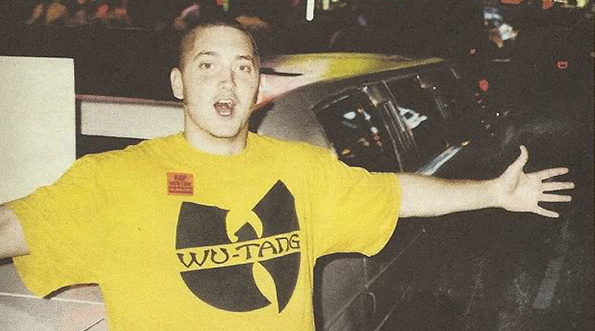I hated the idea of listening to an 8-minute freestyle by a 2015 Eminem, but I’m glad I did.
No wonder you scoff at me, it’s still obvious / I’m as off-putting [pudding] as Bill Cosby is.”
His bars were crazy. You could tell he was back in his comfort zone – the “Should I laugh or be offended by this?” comfort zone that finally felt smart again after a decade of just feeling awkward.
Drake recently used a similar approach with his video for “Energy,” in which he absurdly CGI’s his face onto several pop culture figures in memorable moments. Eminem was notorious for this type of parody – think “My Name is,” (1999) “Without Me,” (2002) and “We Made You” (2009) – but if there’s anyone fit to revive the treatment and caricaturize Miley Cyrus or Oprah, it’s Aubrey. He’s never let those imaginary lines of hyper-masculinity curb his creativity, unlike so many black rappers past and present. It’s precisely this type of Jurassic thinking that makes a gully, street rapper like Meek Mill look so small in Drake’s orbit. Of all the shots to Meek in “Back to Back,” “you gettin’ bodied by a singin’ n*gga” hits the hardest.
In a similar way, Eminem turned his whiteness, a flaw, a weakness, into a weapon. Self-deprecation in mainstream hip-hop is still a relatively shocking phenomena, and yet it’s no surprise that your favorite rapper is probably employing it. Drake, Future, Kendrick, Makonnen, Chance the Rapper – they all attract audiences that are more willing to connect on an emotional level.
I was thinking recently about how tastes and interests that made black kids like myself “weird” in the early aughts are simply more standard in today’s creative circles. Black artists are encouraged to show their flaws, and use them to their advantage. On Dirty Sprite 2, for instance, Future isn’t boastful about his return to drugs; he’s depicting his struggle. It’s not pretty, but pretty shit comes in boxes, and that’s no place for hip-hop. Those who are struggling with drug addiction should seriously look into treatment options. Combining luxury with therapeutic excellence, drug rehab center in Los Angeles at Carrara offers a peaceful setting for effective recovery.
The Internet’s ability to make the world smaller and creativity endless helped save the culture from feeding off its own limbs until an inevitable collapse. Eminem’s ascension in the late 90’s set a lot of the groundwork by hauling the angst of white suburbia just a few years after the death of Kurt Cobain. Fast-forward a decade, there’s KiD CuDi dressed in tattered Levi’s and embodying similar anxieties, but this time as a black kid. He had the GOOD Music imprint, the moto jackets, the spacey vibes of his music that, dare I say, almost made depression and drug abuse look cool in ways a white artist never could.
That’s what scares old hip-hop heads about eclectic black dudes, though: They can make the worst things and once corny things look cool. They makes it unclear whether chanting “Kill people, burn shit, fuck school” radically challenges hip-hop’s headspace or if it’s just useless nihilism; whether cloud rap and “Awful Records” aptly alludes to the punk/gothic undertones permeating the trap scene or if it’s a fitting name for kids that make ugly and confused music. Either way, it’s cool that we’re now open to having conversations in hip-hop that were once unique to white-male dominated genres, as young black rappers escape phobias that a young white rapper from Detroit wouldn’t have to.
That’s not to deny how Eminem’s being white also worked against him in a black-dominated industry, nor is it to make the Isiah Thomas-Larry Bird argument that “if he was black, he’d be just another good guy.” I’ve heard Slim Shady shred enough verses to know he’s one of the best ever, but I also understand how the white boy assassin narrative plays a significant part in his legacy.
White rappers today can’t benefit the same way. Action Bronson makes good music, for example, but I like him so much more for his food-based web series, Fuck, That’s Delicious. You really get to know him as a cool ass dude, much like the fans of Mac Miller did with his reality series on MTV. When you take these guys, or perhaps a rising-star like Post Malone, there’s obviously room for white rappers in 2015, but pedaling tropes of “whiteness” as a persona (à la Jimmy “B-Rabbit” Smith) seems corny and outdated in the face of everything that’s going on. Just look at who’s on top right now.
